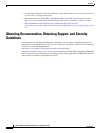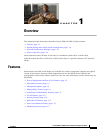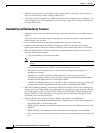
1-5
Catalyst 2960 and 2960-S Switch Software Configuration Guide
OL-8603-09
Chapter 1 Overview
Features
• IGMP throttling for configuring the action when the maximum number of entries is in the IGMP
forwarding table.
• IGMP leave timer for configuring the leave latency for the network.
• Switch Database Management (SDM) templates for allocating system resources to maximize
support for user-selected features.
• Support for Cisco IOS IP Service Level Agreements (SLAs) responder that allows the system to
anticipate and respond to Cisco IOS IP SLAs request packets for monitoring network performance.
• Configurable small-frame arrival threshold to prevent storm control when small frames (64 bytes or
less) arrive on an interface at a specified rate (the threshold).
• Flex Link Multicast Fast Convergence to reduce the multicast traffic convergence time after a Flex
Link failure.
Note To use Flex Link Multicast Fast Convergence, the switch must be running the LAN Base image.
• RADIUS server load balancing to allow access and authentication requests to be distributed evenly
across a server group.
• Support for QoS marking of CPU-generated traffic and queue CPU-generated traffic on the egress
network ports.
• Memory consistency check routines to detect and correct invalid ternary content addressable
memory (TCAM) table entries.
Note This command is not supported on the Catalyst 2960-S switches.
Management Options
• An embedded device manager—The device manager is a GUI that is integrated in the software
image. You use it to configure and to monitor a single switch. For information about launching the
device manager, see the getting started guide. For more information about the device manager, see the
switch online help.
• Network Assistant—Network Assistant is a network management application that can be
downloaded from Cisco.com. You use it to manage a single switch, a cluster of switches, or a
community of devices. For more information about Network Assistant, see Getting Started with
Cisco Network Assistant, available on Cisco.com.
• CLI—The Cisco IOS software supports desktop- and multilayer-switching features. You can access
the CLI by connecting your management station directly to the switch console port, by connecting
your PC directly to the Ethernet management port, or by using Telnet from a remote management
station or PC. You can manage the switch stack by connecting to the console port or Ethernet
management port of any stack member. For more information about the CLI, see Chapter 2, “Using
the Command-Line Interface.”
• SNMP—SNMP management applications such as CiscoWorks2000 LAN Management Suite (LMS)
and HP OpenView. You can manage from an SNMP-compatible management station that is running
platforms such as HP OpenView or SunNet Manager. The switch supports a comprehensive set of
MIB extensions and four remote monitoring (RMON) groups. For more information about using
SNMP, see Chapter 30, “Configuring SNMP.”


















